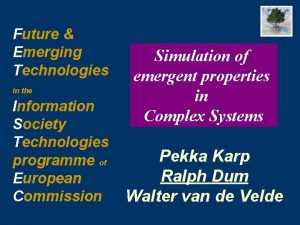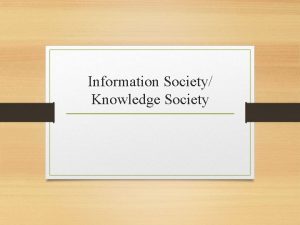Future Emerging Technologies in the Information Society Technologies











- Slides: 11

Future & Emerging Technologies in the Information Society Technologies programme of European Commission Simulation of emergent properties in Complex Systems Pekka Karp Ralph Dum Walter van de Velde

Outline: Towards an expansionist view on systems science l Drivers from science and engineering – Beyond centralised top-down design and single flow control l Inspired by natural and social systems – Decentralised Design 1 st call on Complex systems in FET l Computational science and computational engineering – Convergence of computation with science and engineering – Simulation is central to scientific discovery and systems engineering l Towards an expansionist view of systems science – Need for a systematic understanding of emergence – Focus on system structure rather than components This call on simulation of emergent properties of CS

System design near Complexity barrier ‘Can we control the system without fully controlling the components? ’ • l Radical increase in number of system components – Car industry: 14 system layers 20. 000 parameters …. . – Top-down design (divide and conquer) is computationally hard – A posterior testing replaces a priori verification Components act autonomously in dynamic environments – Need for decentralised control – Components can be unpredictable and unreliable

Data in natural and social science: Too much and yet too little “Even if we understood the system components: How does the system work? “ • Understand how components interact and form dynamic networks sustaining system functionality • • Causal relations in networks e. g. in biology depend strongly on system topology network causality Incomplete data • novel tools for probabilistic reasoning

Inspired by natural and social systems (1) Societies – Ec s m ste Sy o- art Lar ifi ge cia sc l s ale ys tem s fe Li Many heterogeneous, autonomous interacting parts Decentralised approach to system science In natural and social systems, components achieve collectively: • Reliability/robustness • Plasticity • Scalability

Inspired by natural and social systems (2) • Systems can organise in absence of central control • Systems organise in complex hierarchic structures A systematic approach to hierarchical structure is missing ‘Expansionist’ approach to system science Systematic studies of emergent system behaviour via models that integrate descriptions on various levels of aggregation and multiple temporal/spatial scales

Convergence of computing with science and engineering Computing - Simulation Co mp sc utat ien io ce nal l na tio ta pu gn m si de Co Simulation complements testing , prototyping, and experiment Opportunities for expansionist system approach • Simulation to bridge different levels of description • Multi-scale simulation integrated for a whole system view

Three pillars of this call Mathematics Bayesian reasoning Dynamical systems Fo Expansionist system view rm Computing Simulation al lan gu ag e Multi-scale Modelling for a hierarchical system CS in Science - Engineering Simulation allows to connect different levels of description

Objectives summarised l Mathematical framework for hierarchical systems Scalable computational modelling and inference tools l Inference of system models from the dynamic laws governing the interaction structure of components l Develop design strategies for aggregate behaviour to obtain reliability and predictability in presence of uncertainty or in absence of full control at component level

Research Priorities l Hierarchic systems: – How to describe systems acting on multiple scales? – Formal languages for hierarchic model description – Understanding of architecture and functionality of networks l Dealing with incompleteness and uncertainty – Tools for probabilistic modelling and reasoning – Bayesian techniques, evolutionary techniques…. . l Integrated modelling environments – Integrate simulations on different levels/ scales (model embedding) – Integrate data acquisition and modelling

Administrative issues and information l. Submission by 21 st September 2005 at 17: 00 l. Evaluation session: 24 th – 28 th October 2005 l. Start of projects: early summer 2006 l. Size of consortia: typically 4 -8 partners l. Funding: typically 1. 0 MEuros - 2. 5 MEuros l. Duration: 3 years l 2 nd European conference on CS, Paris, Nov. 14 th -18 th lcordis. lu/ist/fet/co. htm complexityscience. org
 See future perfect
See future perfect Future perfect simple continuous
Future perfect simple continuous It infrastructure and emerging technologies
It infrastructure and emerging technologies Emerging technologies introduction
Emerging technologies introduction It infrastructure and emerging technologies
It infrastructure and emerging technologies It infrastructure and emerging technologies
It infrastructure and emerging technologies Emerging database technologies
Emerging database technologies Memory technology in computer architecture
Memory technology in computer architecture Chapter 5 it infrastructure and emerging technologies
Chapter 5 it infrastructure and emerging technologies It infrastructure and emerging technologies
It infrastructure and emerging technologies Emerging database technologies and applications
Emerging database technologies and applications 8 emerging technologies
8 emerging technologies





















